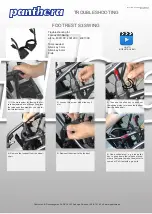
52
CONVAID USER’S GUIDE
Be sure that the shoulder belt crosses the chest and the middle
of one shoulder and that belt restraints are not held a way from
the body by wheelchair components or parts, such as arm rests
or wheelchair legs. (See Fig.186
Thread the lap belt under the frame tubes located directly under
the user’s elbows and pull the belt snug against the pelvis.
Ensure that belt webbing is not twisted as this may compromise
safety. It is best for Cruiser to be transported with the seat in a
relatively upright orientation. However, if the seat must remain
in a tilted position for medical reasons, the seat back should not
be reclined more than 30 º from the vertical. If it is necessary to
recline the seat more than 30 º, move the shoulder belt anchor
point rearward on the vehicle wall so that the shoulder belt re-
mains in contact with the wheelchair user’s shoulder and chest.
Positioning accessories such as pelvic positioning belts, anteri or trunk supports, and lateral
trunk supports may be used while in transit, but are not designed to provide restraint during a
crash. Postural supports and belts should therefore not be relied on for restraint in a vehicle crash
and should be used only in conjunction with lap and shoulder belts that have been designed for
restraint in a motor vehicle and crash tested in accordance with RESNA WC-4-19 and/or ISO
7176-19.
To reduce the risk of potential injury to the wheelchair user or other occupants in a motor-vehi-
cle crash, wheelchair-mounted accessories, such as trays and respiratory equipment, must be
removed and secured separately during transit. Use tether straps or other strong attachment
hardware to prevent items from breaking loose and causing injury during a crash. If it is absolute-
ly necessary to keep a tray on the wheelchair during transit, energy-absorbing padding must be
placed between the edge of the tray and the wheelchair user or serious injury may result during a
crash.
Using Postural Belts & Supports
Trays & Other Wheelchair Components
Fig. 186
















































